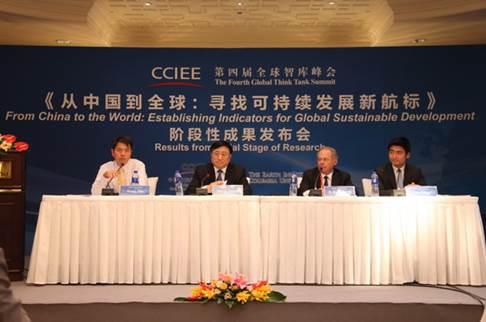Summit Releases Phased Achievements of From China to the World: Identifying New Trends of Sustainable Development - A Study on Sustainability Indicator System
- Time:2015-06-27
- source:CCIEE
On June 27, CCIEE and the Earth Institute of Columbia University jointly released phased achievements of From China to the World: Identifying New Trends of Sustainable Development - A Study on Sustainability Indicator System at the 4th Global Think Tank Summit in Beijing. Mr. Zhang Dawei, Vice Chair and Secretary General of CCIEE, and Prof. Steven Cohen, Executive Director of the Earth Institute, were present at the release. Mr. Wang Jun, Deputy Director of CCIEE Department of Information, and Guo Dong, a postdoctoral researcher at the Earth Institute, introduced their phased achievements on behalf of Chinese and US research teams respectively.

As the teams put it, human progress is accompanied by massive resource consumption, ecological destruction, and the vicious cycle of pollution and poverty. Given a fairly grim outlook for sustainable development, the reduction of energy consumption and pollution has been on the front burner of China’s agenda. A concise set of indicators is in urgent need to measure the balance of the three factors of sustainable development - economic growth, social justice and environmental stewardship.
Based on international experience, the teams have established the new China Sustainability Indicator System made up of 87 basic indicators in 5 categories, namely “social welfare”, “resources & environment”, “human impact”, “sustainable governance” and “steady growth”. Like a natural-capital balance sheet, the system spans the dimensions of, among others, society (“social welfare”), economy (“steady growth”) and nature (“resources & environment”). Targeting at nature, weadd two causality or related topics, namely human impact and sustainable governance on thisbasis. “Resources & environment” describes the current stocks of natural capital; “human impact” manifests the adverse effect of production and consumption on nature, or the reduction of natural capital; and “sustainable governance” reflects the efforts in the stewardship and protection of nature, or the increase of natural capital. The constant improvement in social welfare and resources & environment provides impetus for social development, while steady growth is the premise and foundation of social welfare and sustainable governance.
To build a well-structured system, the teams should uphold the principle of common but differentiated responsibilities, and take into full account China’s status as a developing country in addressing global climate change this global common issue and especially setting goals for the measuring indicators. Eyeing “efficiency control” and “capacity control”, they should set up a complete set of indicators and a performance evaluation system concerned, and shift the target of control from standards to total amount, quality and capacity. They should spare no efforts to reconcile “sustainable production” with “sustainable consumption”, fully aware of the fact that the medium- to high-speed growth and domestic need-oriented transformation of Chinese economy is exerting ever-growing pressure on consumption sectors. Committed to “growth” and “governance” as the two drivers of sustainability, they should highlight the complementary core categories of “steady growth” and “sustainable governance”. They should underscore the harmonious development betweenman and nature, characterized by improved social welfare, economic steady growth, efficient resource utilization, ecological restoration and environmental protection. Living for today and facing future, they should also mull over what they can and should do at present and in the future.
In terms of the five categories in building sustainable development indicator“social welfare” mainly reflects people’s aspiration for a better life, covering education & culture, social justice, income level, social security, and health care; “resources and environment” stresses the ecological “red line” from the perspectives of quantity, quality and environmental system, covering forests, grasslands, wetlands, arable lands, minerals, ocean, fresh water, natural reserves and urban environment; “human impact” mainly manifests the adverse effect of increasing production and consumption on nature, covering resource consumption, pollutant & waste discharge, and greenhouse gas emission; “sustainable governance” is the main approach by which we can exercise a positive influence on nature, covering the decisions and actions from the whole society (capital input and environmental stewardship goal setting); and “steady growth” is the premise and foundation of sustainable development, covering restructuring & upgrading and innovation-driven development.